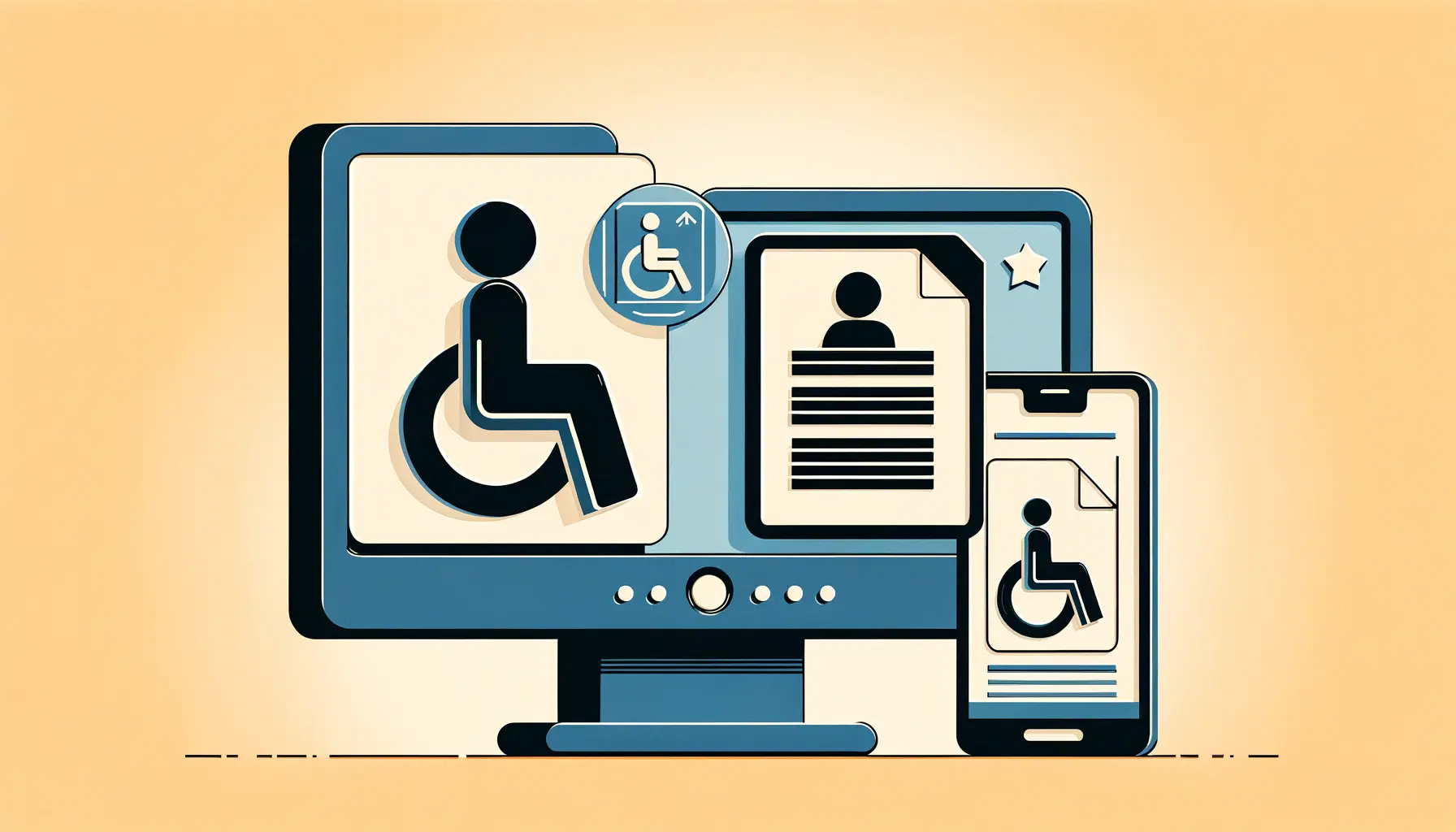Web accessibility is a critical aspect of software development that ensures websites and web applications are usable by everyone, including people with disabilities.
The concept of feedback loops plays a pivotal role in the testing and enhancement of web accessibility.
These loops allow developers and designers to understand how users interact with their products and what barriers they may encounter.
By integrating feedback loops into the development process, teams can create more inclusive digital environments that cater to the needs of all users.
Feedback, in the context of web accessibility, is not just about identifying shortcomings; it’s a dynamic tool for continuous improvement.
It involves collecting insights from real users, including those with disabilities, and using this information to refine and adjust web solutions.
This process helps in pinpointing specific issues that may not be evident during initial development phases.
The ultimate goal is to foster an inclusive digital space that accommodates diverse user needs, enhancing the overall user experience.
- Understanding Feedback Loops in Accessibility
- Strategies for Implementing Feedback Loops
- Challenges in Gathering and Implementing Feedback
- Best Practices for Effective Feedback Loops
- Feedback Loop Tools and Technologies
- Case Studies: Feedback Loops in Action
- Future Directions in Web Accessibility Feedback
- Empowering Accessibility Through Feedback
- FAQs on Feedback Loops in Web Accessibility
Understanding Feedback Loops in Accessibility
At the heart of enhancing web accessibility lies the concept of feedback loops.
These loops are systematic processes that involve the collection, analysis, and implementation of user feedback to refine and improve web accessibility.
The cycle begins with the deployment of a feature or service, followed by the gathering of user feedback through various means such as surveys, user testing sessions, and accessibility audits.
This feedback is then analyzed to identify common themes and areas for improvement.
The insights gained from this analysis are crucial for informing the development team about necessary modifications or additions.
Implementing these changes effectively closes the loop, only for it to begin again with the next set of feedback.
This iterative process ensures that web accessibility efforts are continuously aligned with user needs and expectations, leading to a more inclusive web environment.
Importance of User-Centered Feedback
User-centered feedback is the cornerstone of effective feedback loops in web accessibility testing.
It emphasizes the importance of understanding the user’s experience from their perspective, particularly those with disabilities.
By engaging directly with users who rely on assistive technologies or have specific accessibility needs, developers can gain invaluable insights into the practical challenges faced by these individuals.
This direct line of communication helps in crafting solutions that are not only theoretically accessible but also practically usable.
Moreover, user-centered feedback encourages a more empathetic approach to design and development.
It shifts the focus from compliance with standards to the actual usability and satisfaction of users with disabilities.
This perspective is crucial for creating web experiences that are genuinely accessible and enjoyable for everyone.
Incorporating feedback loops into the web accessibility testing process is essential for creating inclusive digital experiences that cater to the needs of all users, including those with disabilities.
Strategies for Implementing Feedback Loops
Implementing feedback loops in the context of web accessibility requires a strategic approach to ensure that the feedback collected is actionable and effectively contributes to the improvement of the website or application.
Here are some strategies that can facilitate the successful integration of feedback loops into the development process:
Establishing Clear Channels for Feedback Collection
One of the first steps in creating effective feedback loops is establishing clear and accessible channels through which users can provide their feedback.
This can include dedicated feedback forms on the website, email addresses, or even social media platforms.
It’s crucial that these channels are easily accessible to all users, including those with disabilities, to ensure that feedback is representative of the diverse user base.
Additionally, providing multiple channels for feedback allows users to choose the method that is most convenient for them, increasing the likelihood of their participation in the feedback process.
This diversity in feedback collection methods can also enrich the quality of insights gathered, offering a broader perspective on the user experience.
Encouraging User Participation
Another key strategy is actively encouraging user participation in the feedback process.
This can be achieved through various means:
- Incentivization: Offering incentives such as discounts, freebies, or access to exclusive content can motivate users to share their experiences and suggestions.
- Transparency: Clearly communicating the purpose of collecting feedback and how it will be used to improve accessibility can build trust and encourage more users to participate.
- Engagement: Engaging with users through social media, forums, and community events can raise awareness about the importance of their feedback in enhancing web accessibility.
By fostering an environment that values user feedback, organizations can not only improve the accessibility of their web offerings but also build stronger relationships with their user community.
Iterative Testing and Implementation
Feedback loops are inherently iterative, requiring regular testing and implementation of changes based on user feedback.
This involves:
- Regular Accessibility Audits: Conducting regular accessibility audits to identify issues and areas for improvement.
- User Testing Sessions: Organizing user testing sessions with participants who have disabilities to gather firsthand feedback on the usability of the website or application.
- Implementation of Changes: Prioritizing and implementing changes based on the feedback and insights gathered, followed by retesting to ensure the effectiveness of those changes.
This iterative approach ensures that web accessibility is continuously improved, keeping pace with user needs and technological advancements.
Effective feedback loops are built on clear communication, active user engagement, and an iterative process of testing and implementation, ensuring continuous improvement in web accessibility.
Challenges in Gathering and Implementing Feedback
Gathering and implementing feedback in the realm of web accessibility is not without its challenges.
These obstacles can range from logistical issues to the interpretation and prioritization of feedback.
Understanding these challenges is crucial for developing strategies to overcome them and ensure that feedback loops effectively contribute to enhancing accessibility.
Logistical Challenges in Feedback Collection
One of the primary challenges in gathering feedback is the logistical aspect of collecting, managing, and analyzing feedback from a diverse user base.
This includes:
- Volume of Feedback: Handling a large volume of feedback can be overwhelming, especially for smaller teams or organizations with limited resources.
- Diverse User Needs: Feedback from users with different disabilities can be varied and sometimes conflicting, making it challenging to address all concerns.
- Accessibility of Feedback Channels: Ensuring that feedback mechanisms are accessible to all users, including those with various disabilities, requires thoughtful design and implementation.
These logistical challenges necessitate a structured approach to feedback management, including the use of specialized tools and processes to streamline the collection and analysis of feedback.
Interpreting and Prioritizing Feedback
Another significant challenge is interpreting the feedback received and deciding which suggestions to prioritize for implementation.
This involves:
- Identifying Common Themes: Analyzing feedback to identify common issues or suggestions that can impact a larger segment of the user base.
- Assessing Feasibility: Evaluating the feasibility of implementing the suggested changes, considering technical constraints and resource availability.
- Impact on User Experience: Considering the potential impact of the proposed changes on the overall user experience, ensuring that improvements in accessibility do not negatively affect usability for other users.
Addressing these challenges requires a balanced approach that considers the diverse needs of users, the practicality of implementing changes, and the overall goal of enhancing web accessibility.
Overcoming the challenges in gathering and implementing feedback is essential for maintaining effective feedback loops and ensuring continuous improvement in web accessibility.
Best Practices for Effective Feedback Loops
To navigate the challenges of implementing feedback loops in web accessibility testing, adopting best practices is essential.
These practices not only streamline the process but also ensure that the feedback collected leads to meaningful improvements.
Here are some of the best practices that can enhance the effectiveness of feedback loops:
Integrating Accessibility from the Start
One of the foundational best practices is to integrate accessibility considerations from the outset of the web development process.
This proactive approach involves:
- Ensuring that all team members are aware of accessibility guidelines and standards.
- Incorporating accessibility checks and user feedback mechanisms at every stage of development.
- Engaging with users with disabilities early in the design process to gather preliminary feedback.
By making accessibility a core component of the development process, teams can reduce the need for significant changes later on, making the implementation of feedback more manageable and effective.
Utilizing Automated Tools and Manual Testing
Combining automated tools with manual testing is crucial for a comprehensive approach to accessibility testing.
Automated tools can quickly identify technical issues that are easy to overlook, such as missing alt text or incorrect ARIA roles.
However, these tools cannot fully capture the user experience, especially for individuals with disabilities.
Manual testing, particularly with users who rely on assistive technologies, provides invaluable insights into the practical usability of a website or application.
This dual approach ensures a thorough evaluation of accessibility from both a technical and user-centered perspective.
Creating a Feedback-Friendly Culture
Developing a culture that values and encourages feedback is another best practice for effective feedback loops.
This involves:
- Training team members to understand and appreciate the importance of accessibility feedback.
- Creating open channels of communication where feedback is regularly discussed and acted upon.
- Recognizing and rewarding efforts to improve accessibility based on user feedback.
A feedback-friendly culture fosters an environment where continuous improvement is the norm, and accessibility enhancements are implemented more efficiently and effectively.
Adopting best practices for feedback loops in web accessibility testing ensures that feedback leads to meaningful improvements, fostering a more inclusive digital environment.
Feedback Loop Tools and Technologies
In the pursuit of optimizing web accessibility through feedback loops, leveraging the right tools and technologies is paramount.
These resources facilitate the efficient collection, analysis, and implementation of user feedback, making the process more manageable and effective.
Below, we explore some of the key tools and technologies that can support feedback loops in web accessibility efforts.
User Feedback Platforms
User feedback platforms are specialized tools designed to collect and manage feedback from website users.
These platforms offer features such as:
- Customizable feedback forms that can be made accessible to users with disabilities.
- Analytics and reporting tools to identify trends and prioritize issues based on user feedback.
- Integration capabilities with project management tools, ensuring that feedback is directly linked to actionable tasks.
By using user feedback platforms, organizations can streamline the feedback collection process, ensuring that user insights are quickly translated into improvements.
Accessibility Testing Tools
Accessibility testing tools play a crucial role in identifying technical accessibility issues that may not be immediately apparent to users or developers.
These tools can automate the evaluation of web pages against recognized accessibility standards, such as the Web Content Accessibility Guidelines (WCAG).
Some popular accessibility testing tools include:
- WAVE (Web Accessibility Evaluation Tool)
- axe Accessibility Checker
- Lighthouse by Google
While these tools are invaluable for initial assessments, it’s important to complement their findings with manual testing and user feedback for a comprehensive understanding of accessibility barriers.
Project Management Software
Effective feedback loops require efficient management of the tasks and changes that arise from user feedback.
Project management software can help organize and prioritize these tasks, ensuring that feedback is acted upon in a timely manner.
Features such as task assignments, progress tracking, and collaboration tools are essential for keeping accessibility improvement efforts on track.
Integrating project management software with user feedback and accessibility testing tools can create a seamless workflow from feedback collection to implementation, enhancing the overall effectiveness of feedback loops in improving web accessibility.
Leveraging the right tools and technologies is essential for optimizing feedback loops in web accessibility, enabling organizations to efficiently collect, analyze, and implement user feedback for a more inclusive web experience.
Case Studies: Feedback Loops in Action
Examining real-life case studies where feedback loops have been successfully implemented can provide valuable insights into their practical application and impact on web accessibility.
These examples highlight how organizations have navigated the challenges of integrating user feedback into their development processes and the positive outcomes they’ve achieved.
Improving E-Commerce Accessibility
An e-commerce platform noticed a significant portion of their user base experienced difficulties with the checkout process, particularly users relying on screen readers.
By establishing a dedicated feedback channel for accessibility concerns and conducting user testing sessions with individuals with disabilities, the platform gathered specific insights into the barriers these users faced.
Implementing changes based on this feedback, such as simplifying the checkout process and enhancing form label accessibility, led to a marked improvement in the user experience for all customers, not just those with disabilities.
This case study underscores the value of targeted feedback in identifying and addressing accessibility issues that impact user satisfaction and business performance.
University Website Accessibility Overhaul
A university committed to inclusivity sought to overhaul its website’s accessibility.
The project began with a comprehensive audit using both automated tools and feedback from students with disabilities.
This dual approach revealed several areas for improvement, including navigation, content readability, and compatibility with assistive technologies.
By prioritizing these changes based on user feedback and continuously testing the website with a diverse group of users throughout the development process, the university significantly enhanced the accessibility and usability of its site.
This case study demonstrates the effectiveness of feedback loops in creating an accessible online environment that meets the needs of a diverse academic community.
These case studies illustrate the transformative potential of feedback loops in enhancing web accessibility.
By actively engaging with users and prioritizing their feedback, organizations can make meaningful improvements that benefit all users and foster a more inclusive digital world.
Ignoring user feedback can lead to missed opportunities for improving web accessibility and negatively impact the user experience for individuals with disabilities.
Future Directions in Web Accessibility Feedback
The landscape of web accessibility is continually evolving, driven by technological advancements, changing regulations, and the dynamic needs of users with disabilities.
As we look towards the future, feedback loops will play an increasingly critical role in shaping accessible web experiences.
Here are some future directions in web accessibility feedback that highlight the potential for innovation and improvement.
Advancements in Automated Feedback Collection
Technological advancements are set to revolutionize the way feedback is collected, making it more efficient and comprehensive.
Future developments may include:
- Artificial Intelligence (AI) and Machine Learning (ML): AI and ML can be used to automatically analyze user interactions and identify potential accessibility issues, streamlining the feedback collection process.
- Enhanced User Interaction Tracking: Advanced tracking technologies can provide deeper insights into how users with disabilities interact with websites, identifying usability challenges more effectively.
- Automated User Testing: The development of sophisticated automated user testing tools that can simulate a wide range of disabilities, offering a broader perspective on accessibility challenges.
These advancements promise to enhance the efficiency and effectiveness of feedback collection, providing a solid foundation for continuous improvement in web accessibility.
Increased Emphasis on User Empowerment
Future trends in web accessibility feedback will likely place a greater emphasis on empowering users to share their experiences and suggestions.
This could involve:
- Personalized Feedback Mechanisms: Developing feedback tools that are tailored to the specific needs and preferences of users with disabilities, encouraging more meaningful contributions.
- Community-Driven Accessibility Initiatives: Leveraging online communities and forums to gather feedback and foster a collaborative approach to improving web accessibility.
- Direct User Involvement in Development: Inviting users with disabilities to participate directly in the design and development process, ensuring their needs are accurately represented and addressed.
By empowering users to actively participate in the feedback process, organizations can ensure that their web accessibility efforts are genuinely user-centered, leading to more inclusive and effective web experiences.
Regulatory and Standards Evolution
The regulatory landscape for web accessibility is also expected to evolve, with potential implications for feedback loops.
Future developments might include:
- Stricter Accessibility Standards: The introduction of more stringent accessibility standards could necessitate more rigorous feedback and testing processes to ensure compliance.
- Global Harmonization of Accessibility Regulations: Efforts to harmonize accessibility regulations across jurisdictions could lead to more standardized feedback mechanisms and practices.
- Increased Legal Incentives for User Feedback: Legal frameworks may increasingly recognize the importance of user feedback in web accessibility, encouraging organizations to prioritize feedback collection and implementation.
As regulations and standards evolve, feedback loops will need to adapt to meet new requirements, ensuring that web accessibility remains a priority in the digital landscape.
The future of web accessibility feedback is poised for significant advancements, with a focus on technological innovation, user empowerment, and evolving regulatory standards, promising a more inclusive and accessible web for all users.
Empowering Accessibility Through Feedback
In the journey towards creating a more inclusive digital world, the role of feedback loops in testing web accessibility cannot be overstated.
This article has traversed the multifaceted landscape of feedback loops, highlighting their significance, challenges, best practices, and the tools that make them effective.
As we have seen, feedback loops serve as a vital bridge between users, including those with disabilities, and developers, facilitating a continuous dialogue that is essential for enhancing web accessibility.
Key Takeaways
The exploration of feedback loops in web accessibility testing reveals several key takeaways:
- The iterative nature of feedback loops ensures continuous improvement in web accessibility, making digital content more accessible and enjoyable for all users.
- Challenges such as logistical hurdles and the prioritization of feedback are surmountable with strategic planning and the adoption of best practices.
- Tools and technologies, including user feedback platforms and accessibility testing tools, play a crucial role in optimizing the feedback loop process.
- Real-life case studies demonstrate the tangible benefits of implementing feedback loops, showcasing improvements in user experience and satisfaction.
- The future of web accessibility feedback looks promising, with advancements in technology and an increased emphasis on user empowerment and regulatory evolution.
Looking Forward
As we look towards the future, the importance of feedback in testing web accessibility is only set to increase.
With technological advancements, there is potential for more efficient and comprehensive feedback collection methods.
Moreover, a greater emphasis on user empowerment will likely lead to more meaningful and actionable feedback.
The evolution of regulatory standards will also play a significant role in shaping the feedback landscape, ensuring that web accessibility remains a priority.
In conclusion, feedback loops are indispensable in the realm of web accessibility.
They not only facilitate the identification and rectification of accessibility barriers but also foster a culture of continuous improvement and inclusivity.
By embracing feedback loops, developers and organizations can ensure that their digital content is accessible to everyone, thereby contributing to a more inclusive and equitable digital environment.
The journey towards enhanced web accessibility is ongoing, and feedback loops will undoubtedly be at the forefront of this endeavor, driving innovation and progress for the benefit of all users.
Quality web design is key for a great website! Check out our service page to partner with an expert web design agency.
FAQs on Feedback Loops in Web Accessibility
Explore commonly asked questions about enhancing web accessibility through feedback loops.
A feedback loop in web accessibility is a process where user feedback on a website’s accessibility is used to make improvements, enhancing the user experience for everyone.
Feedback loops improve web accessibility by identifying issues from real user experiences, allowing developers to make informed adjustments and enhancements.
Key components include clear feedback channels, active user engagement, iterative testing, and the implementation of changes based on user insights.
Organizations can encourage feedback by providing multiple accessible feedback channels, incentivizing participation, and demonstrating how feedback leads to improvements.
Challenges include managing the volume of feedback, addressing diverse user needs, and prioritizing feedback for implementation.
No, automated tools complement user feedback by identifying technical issues, but direct user feedback is essential for understanding the full user experience.
Project management software organizes tasks and changes arising from feedback, ensuring that improvements are implemented efficiently and effectively.
Future advancements, such as AI and ML, will streamline feedback collection and analysis, making feedback loops more efficient and comprehensive.













